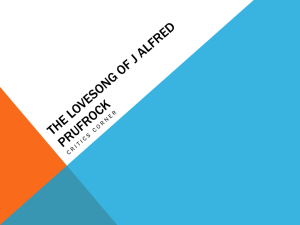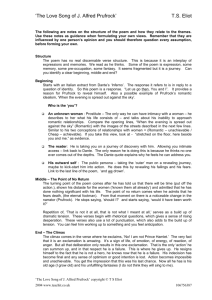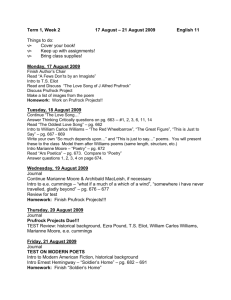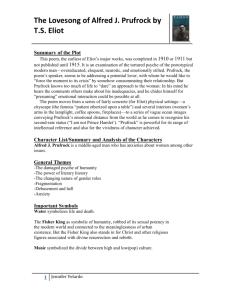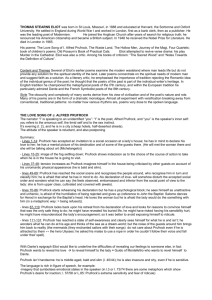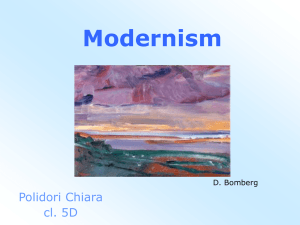T. S. Eliot. An Interpretation of The Love Song of J. Alfred Prufrock
advertisement
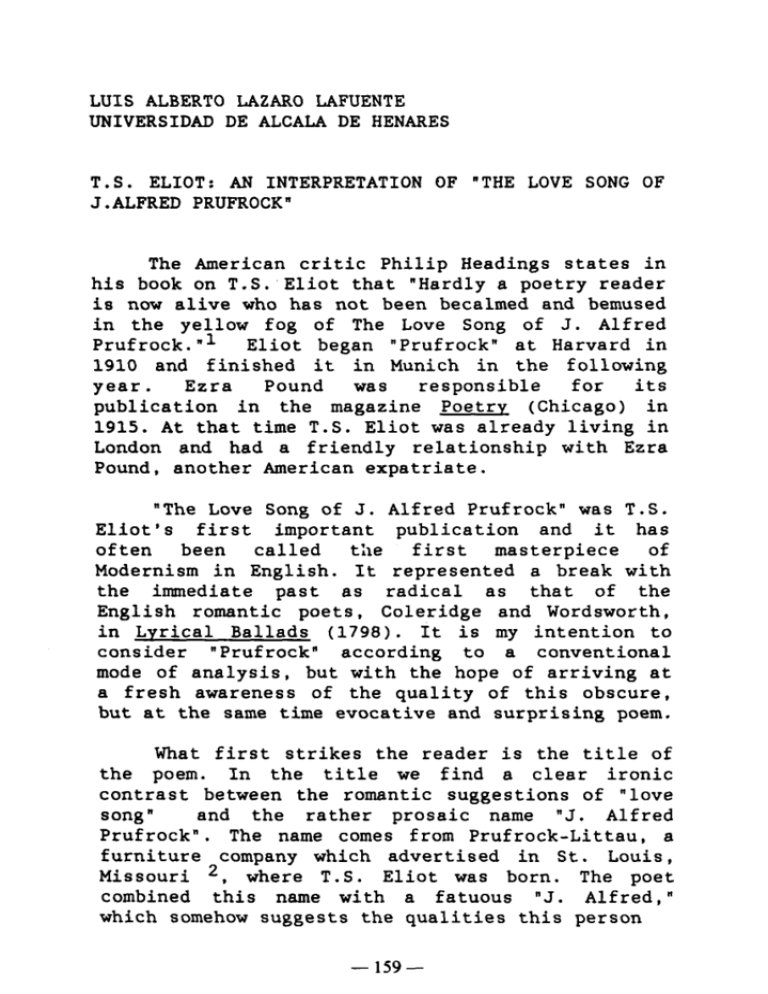
LUIS ALBERTO LÁZARO LAFUENTE UNIVERSIDAD DE ALCALÁ DE HENARES T.S. ELIOT: AN INTERPRETATION OF "THE LOVE SONG OF J.ALFRED PRUFROCK" The American critic Philip Headings states in his book on T.S. Eliot that "Hardly a poetry reader is now alive who has not been becalmed and bemused in the yellow fog of The Love Song of J. Alfred Prufrock."-^ Eliot began "Prufrock" at Harvard in 1910 and finished it in Munich in the following year. Ezra Pound was responsible for its publication in the magazine Poetry (Chicago) in 1915. At that time T.S. Eliot was already living in London and had a friendly relationship with Ezra Pound, another American expatríate. "The Love Song of J. Alfred Prufrock" was T.S. Eliot's first important publication and it has often been called the first masterpiece of Modernism in English. It represented a break with the immediate past as radical as that of the English romantic poets, Coleridge and Wordsworth, in Lyrical Ballads (1798). It is my intention to consider "Prufrock" according to a conventional mode of analysis, but with the hope of arriving at a fresh awareness of the quality of this obscure, but at the same time evocative and surprising poem. What first strikes the reader is the title of the poem. In the title we find a clear ironic contrast between the romantic suggestions of "love song" and the rather prosaic ñame "J. Alfred Prufrock". The ñame comes from Prufrock-Littau, a furniture company which advertised in St. Louis, Missouri 2, where T.S. Eliot was born. The poet combined this ñame with a fatuous "J. Alfred," which somehow suggests the qualities this person — 159 — later shows. There is also irony in the title because it says the poem is a "love song," but then we read something completely different. It is true that there are some elements often used in ballads and songs, such as rhyme, refrain, anaphora, parallelism and incantatory tone; but the poem is not a "love song;" Prufrock never gives utterance to tender or loving feelings in his song. He is unable to love. Before we start reading the poem we still encounter another striking ingredient: the epigraph. There is a contrast between the serious epigraph from Dante's Inferno and the lighter Prufrock's love song announced in the title (in fact, the mixture of levity and seriousness is to be found throughout the whole poem). Whereas we had just been told that the poem is a love song of a character called Prufrock, in the epigraph we are given the words of another character, Guido da Montefeltro, a man condemned to hell in a prison of fíame for his treacherous advice on earth to Pope Boniface ^. Guido tells the shame of his wicked life to Dante only because he believes that Dante will never return to earth to report what he says. A. D. Moody, in his book Thomas Stearns Eliot. Poet. suggests a similarity of the situation between Prufrock and Guido. Both are in hell. Prufrock finds himself in a situation, in a society, which is like hell for him, and believes, like Guido, that there is no way out ^. We should never ignore the epigraph in Eliot because it gives hints of the meaning or the message of the poem. Trying to understand the meaning of "The Love Song of J. Alfred Prufrock" is not an easy task. T.S. Eliot*s poems are difficult, obscure and have a mystery in them. Despite this difficulty, while reading "Prufrock" we can get some Information about the character and his situation that i6 of — 160 — great importance in understanding the poem. In the first line the poet introduces two persons, "you and I" -'. The reader immediately wonders who these people are and where they are going. It is obvious that the "I" is the speaker, and according to the title his ñame is Prufrock; but what about the other person? If we think of the title again, the "you" could be a lady; but the epigraph would suggest a different type of person. It could also be the reader, the one Prufrock speaks to. We do not know yet. We only know that it is evening and that they are walking through the streets of a sordid section of a certain city. We do not know its ñame but it seems representativa of other great cities of modern western civilization. Then the speaker mentions a question, an overwhelming question, but he does not want to talk about it. And since the question is never asked in the poem, the answer is never given. We also learn that they are going to pay a visit to a place in which women talk of Michelangelo. After thinking of the women to be visited, the speaker returns to a visión of the streets, the fog, beautifully described as a cat that falls asleep. It seems that Prufrock is putting to sleep the visión he had of the city and also he is gaining time from the society that is waiting for him in the room where women are talking of Michelangelo. The somnolent image suggests Prufrock's mental state, his desire for inactivity, his indecisión, his passivity and his reluctance to ask the overwhelming question. Prufrock tries to put off the decisión and says that "there will be time" (line 23), though we do not really know for what there will be time. The next section increases the tensión by raising the question "Do I daré?" (line 38). This also shows Prufrock's fear of his society and the — 161 — people In It. Eventually he enters the room and remembers In three rhymlng stanzas the times he has heard the same volees, seen the same people. He knows that soclety very well and he does not llke It. He flnds It trivial and borlng; he says: "I have measured out my U f e wlth coffee spoons" ( U n e 51). Then he starts to rehearse what he dares not to say, and he does not say It. He falls. He never asks the questlon, hls only excuse belng that he Is no prophet, that he does not have the strength of John the Baptlst. After that mock-herolc tone and after that self-justlfIcation, Prufrock looks back upon the event and thlnks about hls fallure. He asks: "Would It have been worth It, after all" ( U n e 87). But hls fear of belng mlsunderstood makes hlm accept hls fallure. If one, settllng a plllow by her head, Should say: "That Is not what I meant at all. That Is not It, at all." (Unes 96-98) These three U n e s glve us a clue to the Inltlal questlon about the Identlty of "you and I." We must conclude that "you" Is never a lady in the poem. She is "one;" the one who settles a plllow by "her" head and is susceptible to misunderstandlng Prufrock. In the last part of the poem there is a great change: from a tone of self-mockery showing Prufrock as the Fool in an Elizabethan play to the language of romantic longlng. Prufrock at the end tries to escape from the real world where he was defeated and he dreams of mermaids. Yet he can not avold the reallty and he drowns. The poem is a song of deslre and fallure. It seems to be the story of what is taking place inside a man called Prufrock. Therefore we can say 162- that the poem Is a dramatlc monologue, a dialogue between "you" and "I," both being the same person. Prufrock talks to himself. The "you" is the passlonate self who insists on going to make the visit. The "I" is the one who consents and says "Let US go then..." (line 1); he is the timid self who does not daré, who does not ask the overwhelming question. If in the epigraph we had Guido's answer to Dante, somebody who, he believed, would never return to the world to report Guido's words, now in the poem we have the words of the condemned "I" who, like Guido, speaks freely only because he is sure that the "you" will not tell anybody about him. Now that we have thrown light on the mystery of the identity of the different people addressed in the poem, we still have to tackle the enigma of the "overwhelming question," which is never formulated in the poem. Is Prufrock trying to issue a marriage proposal? Is he trying to ask the lady called "one" in the poem to marry him or is he just asking about the meaning of this life? The answer may be different for different readers. But it seems to be irrelevant. We simply do not need to know what the question, "the overwhelming question," is. It is enough to know that Prufrock never asks the question; that he is unable to ask it. We should not look for a concealed narrative in the poem. T.S. Eliot is not presenting a story, but a personality. The poem is built around the timid person called Prufrock. This character needs to be analysed. After reading the poem we think of Prufrock as an unattractive middle-aged man who grows oíd (line 120) and talks about his bald spot in his hair (line 40). He is aware of his weakness and disabilities: "I have seen the moment of my greatness flicker,/ and I have seen the eternal Footman hold my coat, and snicker." (lines 84-85) — 163 — Prufrock is conscious of being inferior. He knows he is not Prince Hamlet and he does not think the mermaids will sing to him. He knows that he can not make a decisión. Therefore he takes refuge in selfmockery. He is resigned to his failure. However, he is sensitive to criticism. He knows that people around him remark that his arms and legs are growing thin (line 44) and have him sprawling on a pin (line 57). J. Alfred Prufrock is an unhappy frustrated man. He is involved in a routine of social life and he does not feel comfortable in the society in which he is condemned to live. He sees boredom and monotony. Though he is conditioned by that fashionable society, he seems to be tired of the superficial and miserable existance he is leading. Besides, he is isolated in that alien world. He has a range of more or less obscure feelings that he can not communicate due to his inhibitions and timidity. He then talks to himself and he suffers. Prufrock is a mask, a person through whom the tribulations of the modern city life are spoken. The American teacher and critic Hugh Kenner wrote in his article titled "Bradley" that J. Alfred Prufrock was "a ñame plus a voice." ^ T.S. Eliot used this voice to express the issues and the themes he was pondering over. One of the themes this poem develops is the tedium and dryness of modern life. It is an expression of the futility of life. The reader gets an intense personal view of the society, the city and the world in which Prufrock lives. The poem also conveys a sense of frustration which leads us Into the main issue: the problem of communication. This theme, present throughout much of Eliot*s work, is incorporated in the poem by means of the question which is nevír asked. The speaker can not get his message across. It does not matter whether the recipient of that message is a lady or not. The — 164 — fact is that communication fails. And the failure of communication is related to the theme of the individuales isolation, loneliness, and estrangement from other people. Prufrock is alienated from this world, like Guido and like the "patient etherised upon a table" (line 3). He should have been a crab "scuttling across the floors of silent seas" (line 74). The theme of lack of communication and understanding that Prufrock voices in his monologue has a cióse relationship with the way the poem is written, its style and structure. According to Leonard Unger ', there is a statement in the poem which suggests this connection between the problem of articulation Prufrock suffers and the mode of composition T.S. Eliot chose for his poem: "It is impossible to say just what I meanl/ But as if a magic lantern threw the nerves in patterns on a screen" (lines 104-105). T.S. Eliot, like Prufrock, does not clearly say what he means; instead, like the magic lantern, the poem throws different pictures of Prufrock's mind on a screen. In order to express his feelings, the poet shows different corners of Prufrock's psyche in no particular order (the streets, the room, the fog, the room again, etc.). And all these images put together give the meaning of the poem. Therefore we can not see a logical structure in the poem, despite the fact that it is divided into several sections. There is only the structure of the flow of thoughts in Prufrock's mind. The poem is based on the free association of ideas and images without connective and transitional passages. It renders the flow of impressionsvisual, auditory, physical, and subliminal-- that impinge on the consciousness of Prufrock, a technique similar to the stream of consciousness used by James Joyce a few years later. — 165 — Eliot'8 technlque In thls poem Is llke that of a collage, composed of juxtaposed Images. "Prufrock" is made out of dlfferent elements: Images, llterary references, remarks, the squalor, the beautlful, lyricism, brutality, etc.. The whole sum of the elements bulld up the meanlng of the poem whlle the reader is dellghted in trying to rationalize the association of elements. "The Love Song of J. Alfred Prufrock" is certainly modern in tone and diction. T.S. Eliot wrote a new kind of poetry, with irregular rhyming verse paragraphs, free verse, new themes, and attitudes. In spite of all the different influences, such as the English metaphysical poetry, the French Symbolist Movement, or Henry James °, the poem stlll remains an original piece of poetry. It had a great effect on Modern Literature in English as the critic John Berr3rman States after quoting the third line of the poem: "with this line, modern poetry begins."® — 166 — Notes ^ T.S. Eliot (New York: Twayne, 1964), p. 17. ^ See Hugh Kenner, The Invisible Poet; T.S. Eliot (New York: Harcourt Brace, 1959), p. 3. ^ See B.C. Southam, A Studenfs Guide to the Selected Poems of T.S. Eliot (London: Faber and Faber, 1968), p. 3. ^ Thomas Stearns Eliot. Poet (Cambridge: Cambridge University Press, 1979), p. 37. ^ References to the poem are taken from T.S. Eliot, Selected Poems (London: Faber and Faber, 1961). ® T.S. Eliot; A Collection of Critical Essays (Englewood Cliffs, N.J.: Prentice-Hall, 1962), p. 36. ' T.S. Eliot (Minneapolis: University of Minnesota Press, 1956), pp. 19-20. ° The influence of Henry James on "Prufrock" is mentioned by Grover Smith, T.S. Eliot's Poetry and Plavs; A Study of Sources and Meanings (Chicago: University of Chicago Press, 1956). ^ The Freedom of the Poet (New York: Parrar, Straus and Giroux, 1976), p. 27 — 167 — Supplementary Readlng Bergonzi, Bernard. T.S. Ellot. New York: Macmlllan, 1972. Gardner, Hellen. The Art of T.S. Eliot. London: Cresset, 19A9. Gordon, Lyndall. Eliot's Earlv Years. New York: Oxford University Press, 1977. Haba, J.C. "Till Human Volees Wake Us and We Drown: Community in 'The Love Song of J. Alfred Prufrock'." Modern Language Studies. 7, No 1 (1977), 53-61. Knapp, J.F. "Eliot's ^Prufrock^ and the Form of Modern Poetry." Arizona Quarterly. 30 (1974), 5-14. Matthiessen, F.O. The Achievement of T.S. Eliot. London: Routledge and Kegan Paul, 1952. Maxwell, D.E. The Poetry of T.S. Eliot. London: Routledge and Kegan Paul, 1952. Raffel, Burton. T.S. Eliot. New York: Frederick Ungar, 1982. Ward, D. T.S. Eliot Between Two Worlds; A Reading of T.S. Eliot's Poetry and Plays. London: Routledge and Kegan Paul, 1973. Williamson, George. A Reader's Guide to T.S. Eliot. New York: Noonday Paperback, 1953. — 168 —
